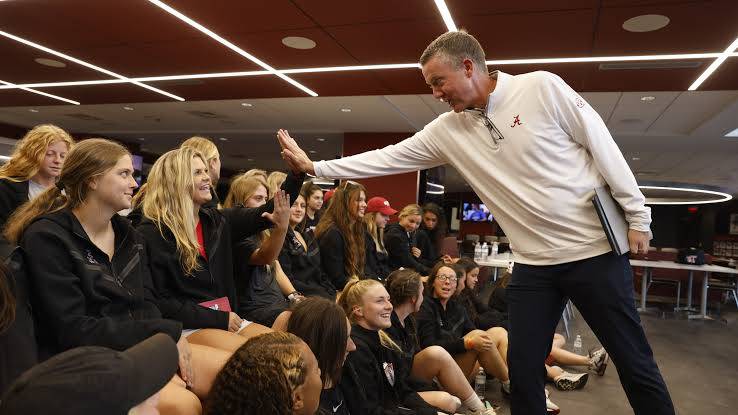The University of Alabama has long been a titan in college athletics, boasting a football program that dominates headlines, generates millions in revenue, and serves as the financial engine for the entire athletic department. But behind the glitz of national championships and sold-out stadiums lies a stark disparity: in 2024, Alabama ranked last in the SEC in equitable spending between men’s and women’s sports, according to financial reports submitted to the NCAA. The numbers reveal a widening gap, with football consuming a disproportionate share of resources while many women’s programs operate with significantly smaller budgets. This imbalance raises critical questions about fairness, Title IX compliance, and whether Alabama—and the SEC at large—is doing enough to support female athletes in an era where women’s sports are experiencing unprecedented growth.
The data paints a clear picture. Alabama’s athletic department spent approximately **$175 million** in 2024, with **$112 million—nearly 64%—allocated to men’s sports**. Football alone accounted for **$85 million**, dwarfing the entire budget for all women’s sports combined, which totaled just **$38 million**. Compare that to SEC peers like Tennessee and Texas A&M, which have made strides toward more balanced spending, and the discrepancy becomes even more glaring. While some argue this is simply the reality of revenue-driven college sports, critics say it reflects an outdated model that undervalues women’s athletics—especially at a time when women’s basketball, gymnastics, and softball are drawing record crowds and TV ratings.
Football’s financial dominance is no secret. The Crimson Tide’s program is a behemoth, generating over **$130 million annually** from ticket sales, media rights, and donor contributions. That money doesn’t just fund Nick Saban’s (now Kalen DeBoer’s) roster; it subsidizes nearly every other sport at Alabama. But the reliance on football revenue creates a structural imbalance. While the men’s basketball team operates on a **$22 million budget**, women’s basketball receives just **$8 million**. Similar gaps exist across the board: men’s baseball ($15 million) vs. softball ($6 million), men’s golf ($3.5 million) vs. women’s golf ($2 million). Even sports where Alabama’s women excel—like gymnastics, a perennial national title contender—operate with budgets that pale in comparison to their male counterparts.
The question isn’t just about money—it’s about opportunity. Title IX, the landmark 1972 federal law, mandates gender equity in educational programs, including athletics. While schools aren’t required to spend equally, they must provide “substantially equivalent” resources in areas like scholarships, facilities, and support services. Alabama complies with Title IX on paper, offering proportional scholarships, but the spending gaps in operational budgets, recruiting, and infrastructure tell a different story. For example, the football team enjoys a **$45 million facility renovation** while the women’s soccer team shares training spaces and travels on commercial flights, unlike the football team’s chartered jets.
Some argue this is simply the market at work. Football drives revenue, so it gets the lion’s share of investment. But that argument ignores the explosive growth of women’s sports. Alabama’s women’s gymnastics team, led by legendary coach Dana Duckworth, has won multiple national championships and regularly sells out Coleman Coliseum. The softball team, under Patrick Murphy, is a perennial College World Series contender. These programs aren’t just successful—they’re profitable. Yet their budgets remain a fraction of men’s sports that often generate far less revenue.
The SEC’s broader trends add context. While Alabama sits at the bottom in spending equity, other conference schools have made adjustments. Tennessee, for instance, has increased investment in women’s basketball and softball, capitalizing on the popularity of players like softball star Kiki Milloy. Texas A&M recently upgraded its women’s soccer and volleyball facilities, recognizing their growing fan bases. Even LSU, another football-first school, has poured resources into women’s basketball following Angel Reese’s national championship run. Alabama, meanwhile, has been slower to adapt, continuing to prioritize football at the expense of other sports.
What does this mean for athletes? For female recruits, budget disparities can influence decisions. A star softball player might choose Oklahoma or UCLA over Alabama because those schools offer better facilities and resources. A gymnast might opt for Florida or LSU, where investments in training centers and NIL opportunities are more robust. In the NIL era, where visibility directly impacts earning potential, unequal exposure and support can put Alabama’s women’s programs at a competitive disadvantage.
The university’s administration has defended its spending, citing the need to maintain football’s elite status. Athletic director Greg Byrne has pointed to incremental upgrades for women’s sports, such as the **$10 million renovation to Rhoads Stadium (softball)** and planned improvements to the soccer complex. But critics say these moves are reactive, not proactive—small concessions rather than systemic change. Meanwhile, football’s budget grows annually, with no proportional increase for women’s sports.
The debate isn’t unique to Alabama. Across the NCAA, schools grapple with balancing revenue-generating football programs with Title IX obligations. But as women’s sports gain momentum—thanks to stars like Caitlin Clark, Dawn Staley’s South Carolina dynasty, and the NWSL’s rising popularity—the pressure to invest more equitably will only intensify. Alabama risks falling behind, not just in fairness but in competitiveness.
If there’s a path forward, it may lie in leveraging football’s wealth more effectively. Instead of pouring millions into yet another football facility upgrade, could Alabama redirect a fraction of that to elevate women’s programs? Could sponsors and donors be encouraged to support softball and gymnastics with the same enthusiasm as football? The success of Alabama’s women’s teams proves there’s an audience; now, the athletic department must match that interest with investment.
The stakes are high. With the SEC expanding in 2024 and media deals bringing in more money than ever, the conference has the resources to lead on equity. Alabama, as one of its flagship institutions, could set the standard—or continue to lag behind. For now, the numbers don’t lie: in the SEC’s financial hierarchy, women’s sports at Alabama are still fighting for equal footing. Until that changes, the university’s claim to athletic excellence will ring hollow for half its athletes.
The Crimson Tide’s dominance shouldn’t come at the cost of fairness. In 2024 and beyond, true greatness means more than just winning football games—it means building a program where every athlete, regardless of gender, has the tools to succeed. Alabama isn’t there yet. But with the right priorities, it could be.



